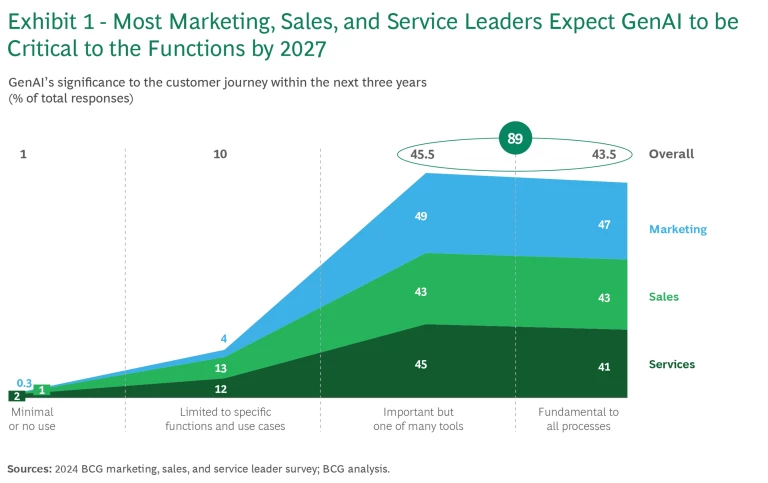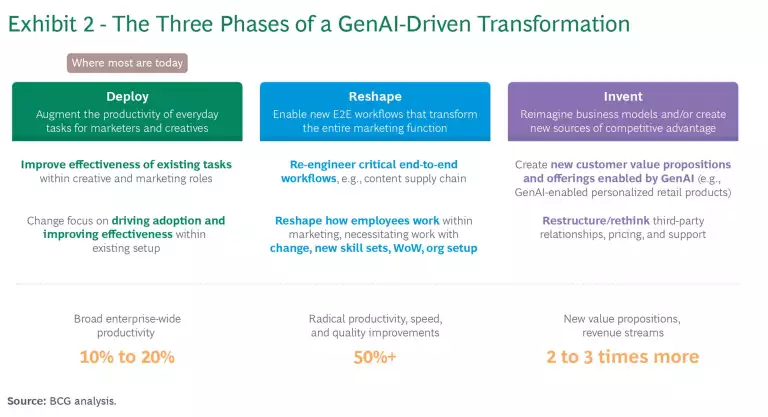Marketing, sales, and service organizations are going all in on AI. Company leaders are making sizable investments and launching pilot projects based on the expectation that AI—and GenAI in particular—will be a cornerstone of re-shaping those functions in the coming years.
However, many B2B marketing, sales, and service first movers that have launched use cases to boost short-term productivity are not seeing the return on investment they anticipated. Almost half aren’t confident they have a solid GenAI strategy or feel neutral about their plans, according to new BCG research.
Quick wins are a great way to start making incremental improvements and get the workforce comfortable with GenAI tools. But creating real, scaled impact requires going beyond just deploying AI to using the technology to fundamentally transform the functions. To do that, leaders must set a unified, bold AI ambition that forces marketing, sales, and service to reimagine core processes and workflows and invent new, innovative experiences to improve the customer journey .
BCG’s
Deploy Reshape Invent transformation framework
is one way for marketing, sales, and service to think about adopting GenAI to transform themselves. By following it, the functions can continue scaling individual GenAI use cases on their own while collaborating to boost organizational value.
The State of GenAI in Marketing, Sales, and Service
AI is taking the corporate world by storm, and GenAI in particular. The 10% of companies that fit BCG’s description of GenAI top performers are beginning to capture real value from the technology ; they’re using it to improve efficiencies, enhance customer experience , and boost revenue. Separate research by BCG Henderson Institute and Harvard Business School found that adopting GenAI leads to 40% higher quality results and 25% faster output .
Companies that lag adopting AI risk being left behind. BCG analysis of future-ready companies identified AI as one of six key attributes that help enterprises withstand disruptions, exploit innovation , and outperform peers across multiple financial and nonfinancial metrics.
In marketing, sales, and service, significant disconnects exist between what leaders expect from GenAI and how they’re rolling it out, according to a BCG survey of 900 executives in middle, senior, and top-level management positions in those functions across a range of industries, regions, and company sizes.

Leaders believe GenAI is transformative. A full 90% of the leaders we surveyed believe that in the next three years, GenAI will be important or fundamental to marketing, sales, and service processes. (See Exhibit 1.)
In addition, almost three-quarters (74%) of leaders expect it to enhance key business metrics, including operational efficiency and sales volume.
At the same time, leaders lack faith in current strategies. Leaders have been excited and active to invest in pilots to explore GenAI’s potential, but they are still hesitant about the potential ROI. More than 70% of leaders say their organizations have piloted at least two GenAI use cases. According to our survey, the top use cases in each function that leaders report launching are:
- Marketing, for content generation (66%)
- Sales, for email creation (50%)
- Service, for automated or generative conversational interfaces for interacting with customers (47%)
In addition, close to 80% of leaders expect to boost GenAI investments in the next 12 months. But close to half (47%) are either not confident or have neutral feelings about their current GenAI strategy.
Subscribe to our Marketing and Sales E-Alert.
Both organizations and leaders are ill-prepared to adopt GenAI. The majority of leaders we surveyed say their organizations are ill-prepared to adopt GenAI solutions or feel neutral about it, including 75% of marketing leaders, 70% of sales leaders, and 67% of service leaders. Leaders may feel their organizations are ill-prepared because of the challenges to adopting GenAI they’ve identified. Those challenges relate to:
- Data quality and knowledge
- Aligning on where to start
- Security and privacy
- Scalability and complexity of integrating AI with existing systems, such as customer relationship management applications
In addition, leaders say they’re ill-prepared on a personal level. More than half don’t use GenAI on a daily basis or have only experimented with it.
Launching a Bold AI Transformation
Deploying AI use cases to improve productivity isn’t enough—many organizations that have done only that are stalled. They’re making minor improvements but not realizing the full value of AI’s potential.
To create value, leaders must be bold. They must use the opportunity of adopting AI to fundamentally reshape marketing, sales, and service, reimagine the functions’ component processes, and invent new experiences throughout the end-to-end customer journey.

The BCG’s Deploy Reshape Invent framework is one way to think about the AI transformation. (See Exhibit 2.) It describes how organizations start out deploying GenAI in everyday tasks and then move to reshaping critical functions end to end for radical efficiency and effectiveness and inventing new experiences, offerings, and business models.
Create a unified AI ambition. The first step in transforming the functions is creating a unified AI ambition. It assures that marketing, sales, and service integrate the technology and data architecture for key processes in the end-to-end customer journey while retaining authority over their individual operations. Such an ambition covers all forms of AI—automation and predictive analytics as well as GenAI.
The goal of a unified AI ambition is figuring out what marketing, sales, and services need to change to improve value within the organization. If creating emails isn’t a problem, deploying AI-based email tools shouldn’t be a priority. But if sales is losing out on potential opportunities because responding to requests for proposals takes too long, one priority could be building an AI-based process to turn RFP responses around in 24 hours.
From there, the functions must determine how they want or need to engage with customers, partners, or employees differently to create that value, and the magnitude of changes required to get there.
The final step is setting organization-level expectations for AI investment and impact across the functions.
Reshape the functions. Defining the AI ambition for the enterprise sets up reshaping the functions. This is where marketing, sales, and service interpret how the ambition comes to life, and how they’ll use AI to change their individual operating models and customer touchpoints, and the skills their people will need to do that.
What needs to be reshaped? Data for starters. To reimagine marketing, sales, and service, the functions need foundational data and data governance that spell out how to authenticate and maintain data quality. If the functions don’t have clean data they can trust, they won’t feel confident building AI-based use cases on top of it.
After defining the first- and third-party data that they need to meet a unified AI ambition, the functions must design a shared database to manage it. Unifying the data layer across the customer journey creates an effectiveness force multiplier. It allows the organization to create use cases by harnessing insights from touchpoints across the customer journey—something that wouldn’t happen if data from each function was stuck inside their individual silos.
Next, the functions must consider what other AI tools could support the changes they’ve identified. Previous BCG research found that top GenAI performers combine GenAI with other forms of AI, including automation and predictive AI. While GenAI is strong at creative tasks, such as content creation, predictive AI excels at many analytical tasks, like interpreting data.
Finally, marketing, sales, and service must assume responsibility for using the data governance, shared data layers, and tools and set objectives for reshaping their own functions. Implementing the strategies should focus on user experience and adoption while driving lovability of the new tools and processes.
Early adopters’ experience with the reshaping process shows the significant value it can create. In marketing, we’ve seen early adopters use GenAI to triple the speed of producing marketing content and reduce production costs by 70%. In sales, they’ve improved how quickly deal teams can respond to simple RFPs. In both examples, the functions are improving efficiency. They’re also shifting the expertise, capability, and fundamental skills required to succeed, from knowing how to create something to knowing how to perfect the messaging.
Invent new experiences. A second goal of a bold AI ambition is to use it to invent new ways of doing things. For marketing, sales, and service, that typically translates into inventing new experiences rather than new products. New experiences tend to fall into two categories:
- Innovative digital experiences that replace human-led experiences
- End-to-end digitized workflows that replace work that previously would be handled by one or more systems or teams
Creating new experiences could involve building new AI models or adopting new tools, or using existing applications in new ways.
Here’s what the AI transformation could look like in marketing, sales, and service in the future:
Marketing Customized to Customer Preferences. An AI-based marketing system could use information a chatbot gathers from a customer conversation to automatically generate a personalized marketing offer or loyalty program rewards tailored to their needs or interests. GenAI-based marketing systems could analyze external data in real-time to suggest, create, and prioritize campaigns, uncover hidden opportunities in the market, or design new products based on focus group feedback.
AI-Supported Sales Activities. AI-based virtual sales assistants could assume most standard front- and back-end sales office tasks to minimize errors and increase efficiencies. Such tasks could include pricing deals and managing approvals. It could also include creating customer presentations, customer profiles, competitive analyses, service summaries, forecast snapshots, and even updating CRM. Relieved of lower lower-level tasks, sales managers and sales reps would have more time for higher value customer interactions such as building solutions, reviewing commercial options, and closing deals.
Automated Low-Level Service. Customer service agents spend significant time on repetitious, low-level activities, such as helping users reset passwords. An AI-based customer service helpdesk could detect multiple failed login attempts that could, based on an organization’s existing knowledge base, indicate someone forgot their password. The system could automatically text instructions for resetting a password to the person and store data on the incident. If the same problem happened a lot, the system could alert the business to investigate and fix a potential user interface issue. If AI assumed such low-level actions human agents could be upskilled to tackle more complex customer success roles, such as driving additional cross-selling.
How to Maximize an AI Transformation’s Impact
According to our research, change management and talent capacity and capability weren’t high on the list of things that marketing, sales, and service leaders considered with when adopting GenAI. But people play such a key role in AI transformations, leaders must embrace change management to reshape work and processes. In fact, previous BCG research found that companies that successfully undertake AI transformations put 70% of the effort into people and processes , including change management, and only 20% on the data and technology backbone, and 10% on algorithms.
To maximize the impact of their AI transformation. Leaders in marketing, sales, and service must implement the following steps to prepare.
Set a bold ambition. Focus on how you can create the most value. Set big targets. Identify the biggest opportunities, such as where you could eliminate cost or pain points in operations or the workforce.
Help your people through the journey. Most marketing, sales, and service functions haven’t provided the intense level of upskilling and change management that the workforce needs in order to function and work in this new world. As organizations’ efforts evolve, they must do more.
- Make leaders the face of change. Our research found that a large portion of marketing, sales, and service leaders still don’t use GenAI in their own daily work. People won’t be motivated if leaders don’t show that they’re committed. Leaders must set the example by modeling desired behaviors and actively participating in AI initiatives.
- Explain how work will change. Detail how AI fits into the functions’ culture and strategy, how it will affect people’s roles, responsibilities, and daily tasks.
- Incentivize people to learn. Give people the right motivations to learn, the autonomy to choose their own upskilling journey, and clear expectations of when it must be accomplished. Show people how the technology will enhance their roles. Use digital nudges or gamification to make learning fun.
- Use AI for upskilling. AI-based tools can help upskill people in such areas as content and personalization. Embedding tools in daily tasks can create a network effect, where the more people use and understand them, the more the functions gain in knowledge, efficiency, and innovation. Organizations can customize upskilling to support tangible business objectives or high-priority use cases.
Invest in your technology. Existing applications should be suitable in most cases. But customized applications may be the only option if an organization is inventing new models or processes. In such instances, leaders must do thorough due diligence on the components and third parties they consider using. They also need to weigh the advantages of investing in existing custom solutions over waiting until more secure, out-of-the-box applications are available.
Get your data ready. Optimize data quality. The GenAI use cases that will usher in the optimized customer journey of the future depend on interconnected systems where data flows freely between the three functions. Integrating data to produce a holistic view of customers’ interactions and history with a brand allows an organization to create more informed, targeted conversations.
Get ahead of data risks. Aside from following responsible AI best practices , marketing, sales, and service can take specific steps to mitigate security risks. Using off-the-shelf or pre-configured GenAI applications can minimize risk more than developing fully customized applications. Another way to minimize risk is to launch pilots in a contained environment where people can iterate on new ways of working while also identifying and resolving potential issues. Pilots could start with such back-end processes as internal sales support or field service helpdesk functions where customers would not be exposed to models that were still being tested.
For marketing, sales, and service leaders, using GenAI in one-off situations or to make incremental improvements isn’t enough. To reach the expected ROI and create real value, these leaders have to be bold in their AI transformations. They need an ambitious, unified plan for how to reshape their operations and processes. And they must lay the human capital and data groundwork to integrate GenAI with other AI technologies to make it happen.











